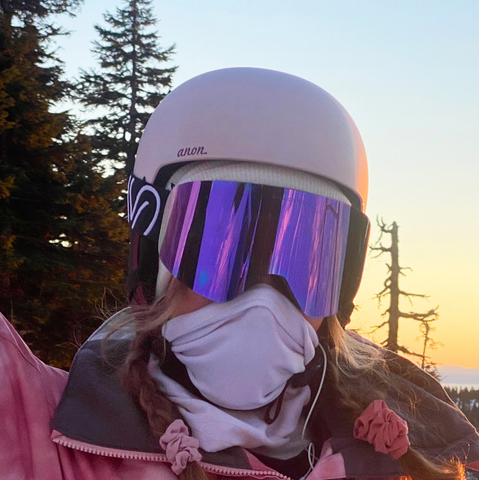Ski Goggle Lens Color Guide
If you’ve ever tried to purchase ski goggles, it’s likely you’ve quickly become overwhelmed. There are so many options when it comes to lens colors, anti-fogging technology options, and more.
But it doesn’t have to be difficult. Not once you understand the meaning behind the tints, and when you should and shouldn’t wear goggles with yellow tints or when you should wear brown tinted lenses.
We’re going to break it down so that when you are picking out your ski or snowboarding goggles the only decision that you’ll need to make is whether or not you should get one pair or two. And even that can be made easy once you see the prices.
Do ski goggle lens' color matter?
The ski goggle colors 100% matter when it comes to how you see in the lighting conditions that you are faced with. Let’s face it, not only can conditions change daily, but they can also change within minutes. You want to ensure that your enjoyment and safety are not affected by the lighting conditions.
And the ski colors tints and choosing the best color lens for snowboarding or skiing affects your visibility. Visibility when skiing down the slopes ensures that you enjoy your time regardless of the lighting conditions and keeps you safe. Once you understand the goggle lens color guide, you’ll be able to easily choose the best ski goggle lens color so that you can enjoy your time on the slopes.

How to choose ski goggle lens color
If you're the type of person that enjoys skiing regardless of the weather and have no interest in changing your lens to accommodate the conditions you’ll want to use a universal lens. A universal lens performs fairly well in all conditions. The best color for ski goggles for universal lenses is a medium copper, rose, or brown tint with little to no mirror. This ski color tint will give you contrast for overcast conditions, and also provide some brightness protection for sunnier days. So no matter what Mother Nature throws your way this lens tint in a medium VLT will keep your eyes protected.
What color goggles for sunny days?
Yellow or gold ski goggle lenses are ideal for flat light. They will enhance details allowing you to see better which helps to avoid rough spots, see ski moguls and eye jumps. Yellow ski goggle lenses are generally the choice for snowy days, because it sharpens vision while also filtering out the snow's brightness and blue light for ultimate protection. You can even wear this color on sunny days, making it the best all-around ski goggle lens tint.
Amber ski goggle lenses, or orange goggle lenses, won’t perform as well as yellow or gold tints when it comes to contrast. This color is best for overcast conditions but will do well on partly cloudy or sunny days. Orange lenses help you to better distinguish moguls and improve visibility in fog. The "copper" colored lens would be best for foggy, overcast conditions. A mid-tone amber goggle lenses, will reflect blue lights and increase shadow definition, which is ideal for all conditions.
Brown, or bronze, ski goggle lenses are great for super sunny days. The bronze tints improve contrast and depth perception and can be worn even when the sun is glaring. Most of the polarized goggles use brown lenses because of how well they are at reducing glare from the sun and snow, and filter out a substantial amount of light. But you wouldn’t want to wear brown or bronze colored lenses during overcast conditions.
Green goggles lenses help to increase contrast allowing for better depth perception, reducing eye fatigue on sunny days, and increasing visual definition in lower light conditions. You’d want to choose a green lens if you ski in partly cloudy conditions often. Green ski goggle lenses can also be worn in overcast conditions to help reduce glare and filter out light and can even be worn on brighter days, as well.
Which color ski goggles is good for low light conditions?
Pink ski goggle lenses, or rose ski goggle lenses, are your best option for low-to-mid light conditions, which includes partly cloudy days, or overcast days with low light. If you enjoy skiing at dusk or dawn these are going to be a good choice. You do not want to wear pink ski goggle lenses on sunny days, as they are not sufficient at filtering out bright light.
Blue lenses are another great option for low light conditions. However, mirrored blue ski goggle lenses will also work in bright light because they are good at cutting glare. And when you couple blue with different tints such as a bronze or copper base tint it will increase your protection for brighter days.

What color goggle lens for night skiing?
Clear ski goggles are going to be the best option for conditions in which light is extremely low, and a necessary option for night skiing, as they do not have any effect on color tones or depth perception. They will provide the necessary protection from the harsh elements when night skiing.
What is contrast-enhancing lens technology?
The contrast enhancing technology is the very same type of technology that is used for color enhancing. When your contrast is improved your visibility improves. You’ll notice that this will amp up the colors and enhance all of the details so that you don’t miss a thing.
What is visible light transmission?
Visible Light Transmission is the amount of light that can come through the lens and go in your eye. The higher VLT means which provides less tint on the lens will allow more light into your eye, a lower VLT will be a darker tint and allow less light to reach your eye.
Here are some basic guidelines that will help you to choose the right VLT lenses for your goggles. These are the VLT percentage ski goggles use,
0–19% VLT: Ideal for bright, sunny conditions.
20–40% VLT: The optimal VLT rating goggles use for all-purpose use.
40+% VLT: Best for overcast and low-light conditions.
The VLT on goggles that you choose need to be determined by your lighting conditions
Snowboard goggle color chart
Understanding the snow goggle lens color guide will help you make the best choice of lens color based on your specific needs. You can easily find a ski goggle color guide online, or you can use the snow lens color guide info from above. This will help you choose the best color for ski goggles.
Once you choose the best color lens for snowboarding, you’ll need to take other aspects of finding the right goggles into consideration such as how well it fits, if you’re wearing glasses or contact lens, are you wearing a helmet and the price you want to spend. Goggles can range from cheap to expensive with everything in between.
At ShadyVEU we not only have a great selection of the best color ski goggles we also have the best prices you’ll find. Are you ready to find the perfect pair of googles for ultimate protection and enjoyment for your next ski trip, check out the wide selection of goggles at ShadyVEU.







Leave a comment